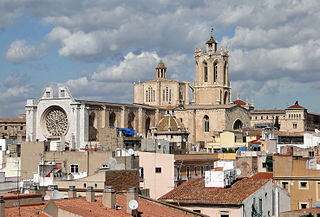
Vic is the capital of the comarca of Osona, in the province of Barcelona, Catalonia, Spain. Vic is located 69 km (43 mi) from Barcelona and 60 km (37 mi) from Girona.

The Diocese of Urgell is a Latin Church diocese of the Catholic Church in Catalonia (Spain) and the Principality of Andorra in the historical County of Urgell, with origins in the fifth century AD or possibly earlier. It is based in the region of the historical Catalan County of Urgell, though it has different borders. The seat and Cathedral of the bishop are situated in la Seu d'Urgell town. The state of Andorra is a part of this diocese.

Josep Caixal i Estradé (1803–1879) was Bishop of Urgell from 1853 until his death in Rome in 1879 and co-prince of Andorra during the New Reform period.

The co-princes of Andorra are jointly the heads of state of the Principality of Andorra, a landlocked microstate lying in the Pyrenees between France and Spain. Founded in 1278 by a treaty between the bishop of Urgell and the Count of Foix, this unique diarchical arrangement has persisted through the Middle Ages to the present. Currently, the bishop of Urgell and the president of France serve as Andorra's co-princes, following the transfer of the count of Foix's claims to the Crown of France and, subsequently, to the head of state of the French Republic. Each co-prince appoints a personal representative. The bishop co-prince is currently being represented by Josep Maria Mauri and the French co-prince by Patrick Strzoda.

Ildefonsus or Ildephonsus was a scholar and theologian who served as the metropolitan Bishop of Toledo for the last decade of his life. His Gothic name was Hildefuns. In the Ethiopian Orthodox Tewahedo Church he is known as Dexius based on the Ge'ez translation of legends about his life.

Saint Ermengol or Hermengaudius was the bishop of Urgell from 1010 until his death in 1035.

The Archdiocese of Tarragona is a Latin Church ecclesiastical territory located in north-eastern Spain, in the province of Tarragona, part of the autonomous community of Catalonia. The archdiocese heads the ecclesiastical province of Tarragona, having Metropolitan authority over the suffragan dioceses of Girona, Lleida, Solsona, Tortosa, Urgell and Vic.

The Catalan counties were those surviving counties of the Hispanic March and the southernmost part of the March of Gothia that were later united to form the Principality of Catalonia.
Saint Nebridius was bishop of Egara (Terrassa) (516–527) and then bishop of Barcelona from 540 to around 547 AD. His feast day falls on 9 February. A native of Girona, Nebridius, according to tradition, had three brothers who were also saints. They were Saint Justus, bishop of Urgell; Saint Elpidius; and Saint Justinian. He was very learned and wrote interpretations of the Scriptures. He also wrote a work called In cantica canticorum about the church chants. He was a Benedictine.

The Cathedral of Saint Mary is a Roman Catholic cathedral located in the city of La Seu d'Urgell, Spain. It is the seat of the Bishops of Urgell, who together with the president of the French Republic are one of the Co-Princes of Andorra. The Cathedral is the seat of the Roman Catholic Diocese of Urgell, the includes also the country of Andorra.

Joan Terès i Borrull was presbyter of Vic, auxiliary bishop of Morocco (1575–1579), bishop of Elne (1579–1586) and of Tortosa (1586–1587), and archbishop of Tarragona (1587–1603). He was viceroy of Catalonia (1602–1603) and councillor of King Philip III of Spain.

The coat of arms of Barcelona is the official emblem of the City Council of Barcelona, the capital of Catalonia, has its origin in the Middle Ages, these arms were first documented in 1329. The Government of Catalonia conferred the coat of arms and the flag as official symbols of the municipality in 2004. It has an escutcheon in lozenge which is commonly used in municipal coats of arms of cities in Catalonia. Currently the City Council of Barcelona also uses an isotype based on the heraldry of the city.
Nambaudus or Anambadus was a bishop of Urgell in northern Spain.
Beatus was the bishop of Urgell between 850 and 857 in the ninth century. He was preceded by Florenci, bishop from 840 to 850; and followed by Guisad I, bishop from 857 to 872.

The Palau de les Belles Arts was a multipurpose building in Barcelona. Demolished in 1942, it was built on the occasion of the universal exhibition of 1888, in the space where the municipal courts are currently located in front of the Parc de la Ciutadella, on the corner of Passeig de Lluís Companys and Passeig de Pujades.
Leuberic or Lubericus was a 7th-century bishop of Urgell in Catalonia. His presence is recorded at the Councils of Toledo in 683, 688 and 693.
Leuderic II was a bishop of Urgell in Catalonia. He succeeded the martyred bishop Nambaudus and was succeeded after his death by bishop Esteve. Little else is known of him.
Juan de la Cruz Baget y Pamiés was a lawyer and commanding officer of the Catalonian somatenes and miqueletes during the Peninsular War.












